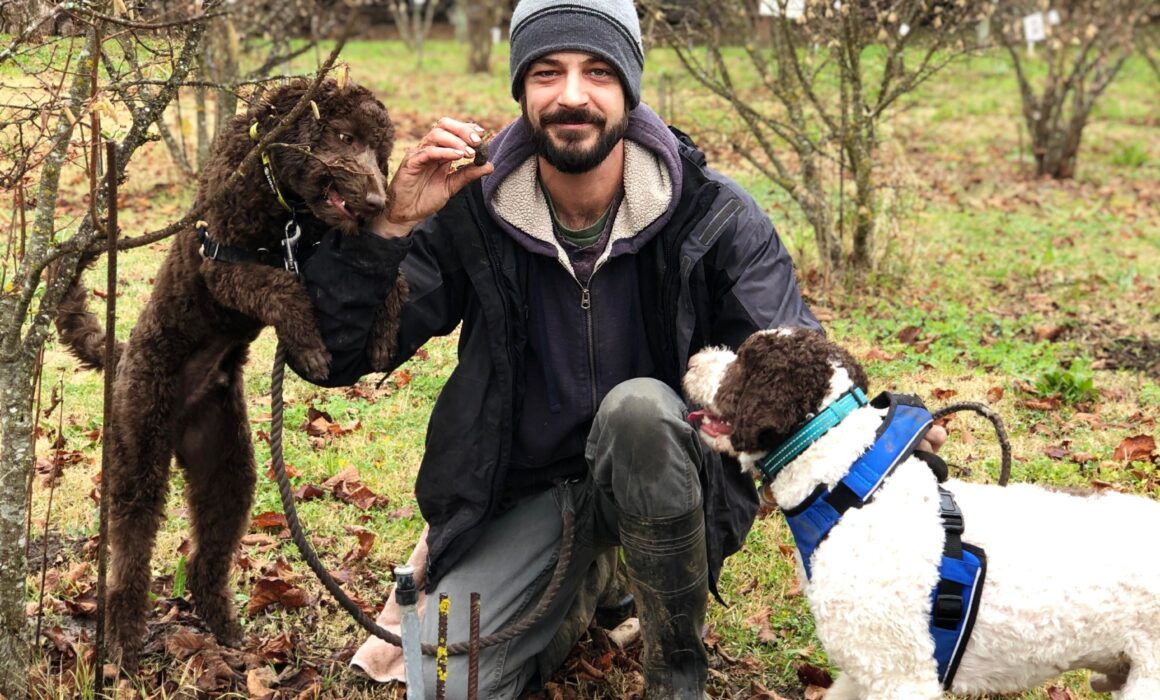The Truffle Hunters of Sonoma County
By Virginie Boone
On Monday July 15th, True West Film Center in Healdsburg will show “The Truffle Hunters,” a documentary film made in 2020 in Piedmont, Italy about men who scour the forests of their region to find white Alba truffles, the most highly sought-after mushrooms on earth. Along with them? Their most trusted companions and money-making tools, truffle-sniffing dogs.
As the film details, the only ones who know how to do this kind of foraging here is this small group of silver-haired Italians and their dogs, who mostly go out at night to search so as to keep their methods and meanderings a secret from menacing outsiders looking to steal their crop.
“The history of human gastronomy is full of mysteries,” reads the first line of critic A.O. Scott’s “The Truffle Hunters” review in The New York Times. “Who figured out that an oyster was something to eat? That fruit juice left sitting around for a while would get you drunk? That a kid would eat the middle of an Oreo first? I am now convinced that these imponderables pale in comparison to the question of the truffle.”
Scott then asks out loud how this subterranean fungus, “the best specimens of which look like woebegone potatoes, came to be among the most prized and pricey of delicacies?”
The film tries to answer this, its subjects mostly men in their 70s and 80s who have devoted their lives to truffle hunting. As it also makes clear, they couldn’t work or live without their dogs – Birba, Ettore, Fiona and Titina.
White truffles are traditionally rooted out by dogs, while black truffles grown in France, also called Périgord truffles, are usually rooted out by pigs. Either way, these are some of nature’s finest gifts, able to command up to several thousand dollars a pound, the spore-bearing fruit of a fungus that grow entirely underground, usually four to six inches below.
Eater’s Elissa Suh describes “The Truffle Hunters” as “An ode to slow living, the movie captures a humble tradition, its observational style subtly exposing greater socio-political issues that surround a luxury business.”
Kendall-Jackson Master Culinary Gardener Tucker Taylor knows a lot about the issues that surround a luxury business that grows in the ground, having spent five years farming specialty produce for The French Laundry in Napa Valley before coming to Kendall-Jackson Wine Estate & Gardens in Santa Rosa, where he’s been since 2013.
There, he tends to the culinary gardens and travels the world looking for new and interesting crops to grow in Sonoma County, much of which gets sold to Bay Area restaurants.
He also has two truffle dogs, Tira and Tito, who can be found on Instagram as #tirathetruffledog and #titothetruffledog. Both are Lagotto Romagnolos, an ancient breed tied to Italy known for their ability to sniff out truffles.
Taylor is also a member of the North American Truffle Growers Association, a group devoted to the awareness and growth of the truffle industry here. It estimates that there are 200 truffle installations in the U.S. ranging from a few trees to 12,000 in one orchard. The first truffle crop was harvested in Northern California in the 1980s.
As Gaye LeBaron detailed in a 2021 story for The Press Democrat, Sonoma County’s flirtation with truffles started with Henry Trione. In his younger years he and his wife Madelyne sailed on a luxury liner from New York to Europe, enjoying black truffles along the way. Henry was already familiar with white truffles thanks to his Italian lineage and the relatives who would send the delicacies back to their kin in the U.S.
When they finally docked in Europe, the Triones and their traveling companions Lois and Roger Stone went straight to Italy to search out truffle-hunting dogs for a new American-based truffle endeavor, forming a partnership called Tristo.
Tristo staged the first-ever California Truffle Congress in Santa Rosa in 1975, declared by the city as the First Annual Truffle Week. Soon after, Rondanella and Urbetta, two truffle dogs, arrived from Italy by private plane. But alas, they didn’t seem to care for finding truffles here.
Others persevered and today there are handfuls of truffle orchards around Sonoma County, including one tended by KJ’s Taylor, which grows both oak and hazelnut trees, first planted in 2011.
Last November, John Beck in Sonoma Magazine laid out the current state of truffles, likening it to the early days of wine:
“Of the various species, the white truffle, Tuber magnatum, is the most prized. Growing wild in the Piedmont region of northern Italy, it can fetch as much as $4,000 a pound. Native to southern Europe, the Périgord black truffle, or Tuber melanosporum, is now widely cultivated around the world by inoculating the roots of oak and hazelnut trees with truffle spores. Farmers in Australia and New Zealand have been very successful at growing what chefs call ‘black diamonds.’ In parts of the United States, the soil and climate are touted as promising for truffles – but the field is still very much in the early, pioneering stage, similar to where winegrapes were more than 75 years ago.”
Among these pioneers are the folks behind the Alexander Valley Truffle Company, who inoculated hazelnut trees with black truffle spores in 2012. Also known as Angerer Family Farms, growing fruit, vegetables and eggs, they now have 1,500 trees on eight acres and five Lagotto Romagnolo dogs: Tuber Giana, Leo, Vito, Bella and Luke.
They might need to be the stars of a new film.
Image by Alexander Valley Truffle Company.


